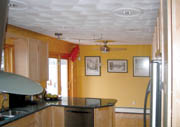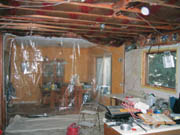

"We were scared to death (to trust this to a stranger)," according to Tina Green.
However, the Greens knew better than to consider replacing the existing plaster ceiling with drywall. As there are posts throughout the space, to preserve this, they had to stay with plaster. John Green initially planned to attempt the project himself.
"The cabinets hung down," he says. "Since we had to demolish some of the kitchen space anyway, we decided to just to take it all out. I can't do this kind of work. I either work with the ceiling I got or gut it and do drywall, which I didn't want to do. When we went with wet plaster, it was a short jump to do something nice with it."
Trying to find someone who does wet plaster was
a challenge.
"We sent e-mails, tried to find someone who did this," says Tina. "Nobody does plaster! We had a lot of people who thought plaster meant drywall. Jim actually sounded like he knew what he was doing and apparently, he was right!"
After utilizing an online directory, ServiceMagic Inc. (W&C Nov. 2004), the Greens found Jim Conklin, plasterer, who knows what he's talking about because he was taught the trade of plaster by one of the last old masters, Ralph Gray. Conklin assessed the project and took the job.
"I've worked on enough projects that I had a clear understanding what it would look like," explains Conklin.
Ralph Gray, however, would still be on hand to observe his pupil's progress.
Much to learn, you still have
Conklin, although currently one of the plasterers out there doing the work the right way, started in drywall and even that was a fluke."I ended up in the drywall trade by default when I couldn't find any other work in the recession of the mid-1980s," he says. "There was some pickup in the construction trade and I worked with a guy doing drywall. Not what I was looking for but I found out I was good at it. I worked for him for a few months but I was unhappy because I was having trouble getting paid. I decided to go into business for myself. I felt my employer was not a good businessman, although he was good at his work. But people couldn't cash their paychecks."
Conklin was doing drywall remodeling work for contractors and he had a job where three wings were being put on a house in Ann Arbor, Mich., and the contractor had gutted all the plumbing and electrical throughout the house. This was all drywall and Conklin didn't yet have the experience to do this intricate of a project.
"I was a good finisher but the repair work was different," he adds. "One of the guys on my crew said he knew an old man who could do it."
Having no alternative, Conklin gave the OK for the "old man" to come to the project.
"So, this old man comes in, bent over, big chew of tobacco in his mouth," Conklin says.
"Yeah, I can do that kind of work. Broke my neck a few years ago."
"Can you move your arms up?"
"Yeah. Can get my right arm up to my waist. Can get my left arm up to my shoulder."
I gotta be nuts to hire this guy.
"He said he could do the work and two hours later, I was watching him," Conklin remembers. "And this old man's hands never made a mistake. Every move he made counted and I realized I could learn a lot from this guy. That was 1987 and his name is Ralph Gray."

Gray matter
Gray dropped out of high school and started plastering at the age of 15. However, in the 1950s, becoming a plasterer was a long way from doing any actual plasterwork."For three years, all they would let him do was carry things," Conklin says. "They wouldn't let him touch a trowel for three years-old school."
Old school is the way Gray was taught and it is the way Gray taught Conklin. It is the only way he knows.
"He did the same for me," Conklin continues. "He worked with me doing drywall, helping me become a better finisher for three years before he offered to teach me how to do plaster. I'm the only one he's taught since 1963. And he still comes out on jobs with me and mixes mud with me, and I'm still learning."
Unfortunately for Gray and his fellow tradesmen, the coming of drywall had a negative effect on their trade. These old craftsmen, who wouldn't share their secrets easily, resisted drywall and many became embittered by drywall's proliferation. Conklin says that when drywall came to Detroit in 1963, the plasterers union had more than 3,000 people working. In a year, the union had 300.
"Drywall destroyed their trade," Conklin adds. "A lot of them were so bitter, they left the trade and took their secrets with them."
In Conklin, however, the trade lives on. Gray would eventually share his knowledge.
"Today, he's 68. He's got more use of his arms now ... but he had to have triple-heart bypass from helping an old lady with a stuck car in a snowstorm. He fell under the car and lay there for hours. Last year, one of his bypasses plugged up and we almost lost him to congestive heart failure. But he's up muzzleloader hunting right now! All work stops when hunting season starts."
For awhile, Gray had Conklin apply the finish of drywall with a trowel and hawk, doing drywall work with plastering tools to get him used to them. When Gray was satisfied, he told Conklin it was time for plaster.
"Get us a plaster job and I'll teach you how to do it. You have good hands and I can't do work over my head. Most work is done over your head and your hands are good. More important than that, you listen."
To get a plaster project, Conklin talked to a contractor he was doing some work for and learned the contractor was doing an addition on a home in one of Ann Arbor's classic neighborhoods. The homeowners wanted to keep the addition all in plaster.
"I told him I'd do it for 25-percent less than any other bid just to get it," Conklin says. "I took Ralph over to see the job. Now, when Ralph broke his back, when they set the bones in his neck, they didn't think he'd ever walk again, so his head is stooped over. He tilted it back, looked up, saw the (difficulty of the) job and said, ‘Only you, Jim.'"
Gray informed Conklin that this wasn't a flat ceiling it was a barrel-rolled ceiling.
"The first few hours on it were rather traumatic," Conklin recounts. "Plaster is a cement product, not a drywall product, so there's no adhesives in it. It does not stick to your hawk and trowel so if you tilt it slightly, gravity does the rest. The first three hours, I had more plaster on the floor than on the ceiling. But the job came out beautifully."
Conklin's next goal is to go down to Georgia and go to the School of Italian Plaster.
As for the Green ceiling, the job came out beyond their expectations. The kitchen ceiling fluidly links to the living room ceiling, including a custom medallion from which hangs a light fixture that required Gray to teach Conklin how to custom make tools to handle such circumstances.
"Ralph taught me how to do cornice work and how to make these kinds of tools," Conklin says. "Plaster is a different media, completely different from drywall. It has that beautiful polish to it."

Report Abusive Comment